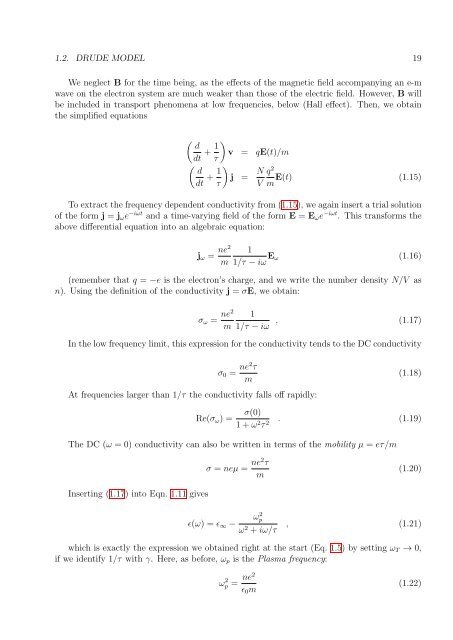Set of supplementary notes.
Set of supplementary notes.
Set of supplementary notes.
Create successful ePaper yourself
Turn your PDF publications into a flip-book with our unique Google optimized e-Paper software.
1.2. DRUDE MODEL 19<br />
We neglect B for the time being, as the effects <strong>of</strong> the magnetic field accompanying an e-m<br />
wave on the electron system are much weaker than those <strong>of</strong> the electric field. However, B will<br />
be included in transport phenomena at low frequencies, below (Hall effect). Then, we obtain<br />
the simplified equations<br />
( d<br />
dt + 1 τ<br />
)<br />
v = qE(t)/m<br />
( d<br />
dt + 1 τ<br />
)<br />
j = N V<br />
q 2<br />
E(t) (1.15)<br />
m<br />
To extract the frequency dependent conductivity from (1.15), we again insert a trial solution<br />
<strong>of</strong> the form j = j ω e −iωt and a time-varying field <strong>of</strong> the form E = E ω e −iωt . This transforms the<br />
above differential equation into an algebraic equation:<br />
j ω = ne2<br />
m<br />
1<br />
1/τ − iω E ω (1.16)<br />
(remember that q = −e is the electron’s charge, and we write the number density N/V as<br />
n). Using the definition <strong>of</strong> the conductivity j = σE, we obtain:<br />
σ ω = ne2<br />
m<br />
1<br />
1/τ − iω , (1.17)<br />
In the low frequency limit, this expression for the conductivity tends to the DC conductivity<br />
σ 0 = ne2 τ<br />
m<br />
At frequencies larger than 1/τ the conductivity falls <strong>of</strong>f rapidly:<br />
(1.18)<br />
Re(σ ω ) =<br />
σ(0)<br />
1 + ω 2 τ 2 . (1.19)<br />
The DC (ω = 0) conductivity can also be written in terms <strong>of</strong> the mobility µ = eτ/m<br />
σ = neµ = ne2 τ<br />
m<br />
(1.20)<br />
Inserting (1.17) into Eqn. 1.11 gives<br />
ɛ(ω) = ɛ ∞ −<br />
ω 2 p<br />
ω 2 + iω/τ<br />
, (1.21)<br />
which is exactly the expression we obtained right at the start (Eq. 1.5) by setting ω T → 0,<br />
if we identify 1/τ with γ. Here, as before, ω p is the Plasma frequency:<br />
ω 2 p = ne2<br />
ɛ 0 m<br />
(1.22)








